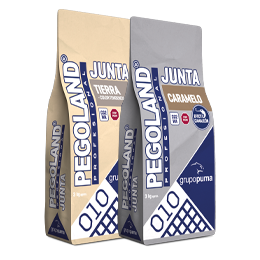 Pegoland® Profesional Junta CG2 FWA
Pegoland® Profesional Junta CG2 FWA

Decorative solution for the gluing of high performance ceramics; with TECNO-ADAPT technology; with low dust emission; including low VOC emission and bacteriostatic properties; antifungal and anti-algae; anti-florescent and hydro-repellent; quick drying and quick setting; high resistance to abrasion and possesses great plasticity; for the sealing of joints up to 20mm. Grouting of all kinds of ceramic parts, heavy traffic, pools, floors with underfloor heating and for the application in areas where a there is a risk of spreading microorganisms.
Additional information
Technical Caracteristics
Base product of special binders (not containing portland cement), high purity select aggregate, pigments, synthetic resins, special fibres and additives of the latest technology.
Advantages and Uses
- Grout for paving and coating, interior and exterior, for all kinds of ceramic parts, grey porcelaine, marble, granite, glass mosaic, natural stone.
- Grouting of places with heavy traffic, residentials, pools, facades, balconies, terraces, floors with underfloor heating.
- Aquastop effect: repels the surface water on the joint provoking a pearl effect, its low porosity surface with minimum water absorption, allows for the joint to be cleaned very easily.
- Hygienic grout including BIOACTIVE TECHNOLOGY which stops the spread of microorganisms (fungi and algae) in damp climates. It is also a bacteriostatic grout, being an inert medium which stops the growth of bacteria on its surface.
- Mortar that stops the suspension of dust particles in the air. low VOC emission.
- Quick and easy cleaning during its application with a quick, optimum finish.
- Grout resistant to cracking and fissures, because of its low shrinkage and great durability, thanks to its great resistance to abrasion and high mechanical resistance, including in freeze/thaw cycles.
- Even colours, thanks to a technology that blocks the saline efflorescence. It doesn't contain portland cement: consequently, in the hydration of the product, calcium hydroxide crystals which generate efflorescence are not produced, avoiding this unwanted effect in colour and finishing for the joint.
- UV ray and exposure resistant colours on the outside.
- Great resistance to oils, solvents, alkali and acids of a pH>3.
Suitable Substrates
- Before applying the grout, wait for the adhesive to be completely hardened, checking that the waiting time indicated in its data sheet has passed.
- The empty joints must be dry and clean, without dust or remnants of adhesive in all its length and depth. They must have a even depth, a minimum of 2/3 of the total thickness.
- Some ceramic tiles may show micropores or surface roughness. It is recommended that a preliminary test is carried out to verify if it can be cleaned and, when necessary, apply PROTECMOR temporal pore covers on the surface to avoid possible pigment stains penetrating the surface of the tiles.
Application Procedure
- Add water, 19-25%, (approx. 0.57-0.75 litres per bag of 3kg) and mix manually or mechanically with a spiral mixer at low revs (approx. 400rpm) obtaining a consistent, homogenous and lump-free paste (not liquid). Leave the paste to rest for 2 mins. and remix again.
- Mix a quantity which you can use within 20-25 minutes of mixing.
- Refill the joints using a rubber trowel and compact the material firmly without leaving holes. Remove the excess paste whilst fresh, passing the rubber trowel diagonally to the joints and taking away the excess material.
- Leave the material to dry slightly, in approx. 15-30 mins. when the paste turns matte, the cleaning of the surface can take place, using a slightly damp, hard sponge, of a large size to avoid emptying the joints. Move the sponge in a spinning motion to remove the surplus hardened grout and finish by moving the sponge diagonally to the joints. Rinse the sponge with clean water frequently and always use an even amount of water to avoid producing changes in tonality.
- Only when the product has hardened in the joint can the surface be polished with a clean, dry cloth to avoid traces of dust (you must avoid premature cleaning, for if the grout remains in the paste, the joint may be impaired and changes in colour may occur).
- If the tiles are left stained after the last clean, a DESMOR cement de-encrustator may be used (see the instructions on the data sheet) for its cleaning, using it always on tiles with a acid-resistant surface and ensuring that it does not touch the joints. Rinse the tiles with clean water to avoid leaving acidic residues on them.
- The grouted surfaces may be moved 3 hours after its application. Its putting into operation is 24 hours; in tanks and pools, 48 hours.
Recommendations
- Do not apply below 5ºC nor above 30ºC.
- Do not apply where there is a risk of freezing, rain, strong winds or direct sun.
- Do not add water in excess, for this may reduce the final performance. Do not use on brackets which are subject to rising damp.
- Fill the joints when the paving or coating is completely dry.
- In the case of very absorbant tiles or high temperatures, just before filling the joints, dampen the joints with clean water, passing a damp sponge over them, avoiding the waterlogging of water on its interior.
- Do not clean the joint with too much water or con other acids, as this would affect its colouration.
- In tanks or pools, wait at least 48 hours after the grouting for the first filling.
- MORCEMCOLOR PROFESSIONAL UNIVERSAL does not contain Portland cement and must not be mixed with plaster or with other hydraulic binders. Never mix with brackish or dirty water and never add water to the mix that has begun to set.
- Where resistence to acids or high levels of hygiene are required, we advise using MORCEMCOLOR EPOXI.
- You must not in any case lay a ceramic coating without a joint or a "head". Only in the case of good dimensional quality tiles, indoors, upon stable brackets on pavings without mechanical requirements, may a joint of a minimum of 1.5mm be hanged, according to what is contemplated in the UNE rules 138002.
- Do not use on expansion joints, fractionating joints or joints subject to structural movements. These joints must be filled with a deformable material from the PUMALASTIC range.
- The working times of the joint may be extended or reduced according to the environmental temperature and the temperature of the mixing water.
- Do not clean with an excess of water, or with still fresh material, to avoid the emergence of covers or tones of colour on the surface.
Consumption according to dimensions (kg/m²)
| TILE FORMAT |
|
||||
| 2 mm | 5 mm | 10 mm | 15 mm | 20 mm | |
| 15 x 15 cm | 0,27 | 0,68 | 1,36 | 2,04 | 2,72 |
| 15 x 20 cm | 0,24 | 0,60 | 1,19 | 1,79 | 2,40 |
| 20 x 20 cm | 0,20 | 0,51 | 1,02 | 1,63 | 2,05 |
| 25 x 33 cm | 0,14 | 0,36 | 0,72 | 1,08 | 1,45 |
| 30 x 40 cm | 0,12 | 0,30 | 0,60 | 0,89 | 1,20 |
| 40 x 60 cm | 0,09 | 0,21 | 0,43 | 0,64 | 0,85 |
| 45 x 80 cm | 0,07 | 0,18 | 0,35 | 0,53 | 0,70 |
| 2 x 2 cm | 1.3 (estimate for width of the 4mm joint) | ||||
|
((A+B)/AxB) x C x D x 0.17 = Kg/m² Where: B = length of the tile (cm) C = thickness of the tile (mm) D = breadth of the tile (mm) |
|||||
Packaging and Storage
Packs of 3kg.
Up to 2 years storage in its original sealed packed, away from weather conditions and humidity.
Technical data
(Statistic results obtained in standard conditions, at +23ºC and 50% HR)
| Classification according to UNE-EN 13888-1 | CG2 F W A |
| Classification according to ISO 13007-3 | CG2 F W A |
| APPLICATION DATA AND ASPECT | |
| Aspect | White and range of colours |
| Mixing water | approx. 0.57-0.75 litres per bag of 3kg |
| Temperature of application | +5°C a +30°C |
| Duration of the mix | 20 - 25 min |
| Waiting time for finish | Trafficability Approx .3 hours |
| Putting into operation | 24 hours (48 hours in tanks and pools) |
| FEATURES | |
| Resistencia a compresión después de 6 hours | ≥ 7,5 N/mm2 (EN 12808-3) |
| Resistance to bending after 28 days | ≥ 5 N/mm² (EN 12808-3) |
| Resistance to compression after 28 days | ≥ 30 N/mm² (EN 12808-3) |
| Resistance to bending after freeze-thaw | ≥ 5 N/mm² (EN 12808-3) |
| Resistance to compression after freeze-thaw | ≥ 30 N/mm² (EN 12808-3) |
| Retraction | ≤ 1,5 mm/m (EN 12808-4) |
| Abrasion | ≤ 700 mm³ (EN 12808-2) |
| Absorption of water after 30 mins. | ≤ 0,2 g (EN 12808-5) |
| Absorption of water after 240 mins. | ≤ 0,5 g (EN 12808-5) |
| Operating temperature | -20°C a +80°C |
| Resistence to acids | Good (si pH>3) |
| Resistence to alkalis | Optimum |
| Resistance to oils and solvents | Optimum |
Legal Disclaimer
The instructions for use are given according to our tests and knowledge and do not imply any commitment by GRUPO PUMA nor free the consumer from the examination and verification of the products for their correct use. Claims must be accompanied by the original packaging to allow a proper traceability.
GRUPO PUMA is not responsible, in any case, for the application of its products or constructive solutions carried out by the application company or other parties involved in the process and / or execution of the work, limiting the responsibility of GRUPO PUMA exclusively to the damages directly attributable to the supplied products, individually or integrated in systems, due to failures in their manufacturing process.
In any case, the drafter of the work project, the technical management or the person responsible for the work, or collaterally the application company or other parties involved in the process and / or execution of the work, must ensure the suitability of the products addressing the characteristics of them, as well as the conditions, support and possible pathologies of the work in question.
The values obtained by GRUPO PUMAS's products or its constructive solutions that, as the case may be, are determined by the EN standards or any other regulation that applies to it in each case refers exclusively to the conditions specifically stipulated in said regulation and that are referred to, among others, to certain characteristics of the support, humidity and temperature conditions, etc. without being them required in the tests obtained under different conditions, all in accordance with the relevant regulation.